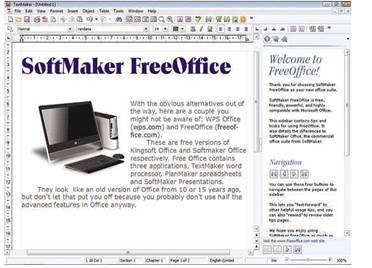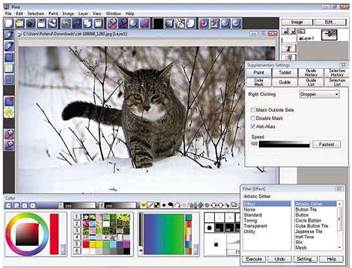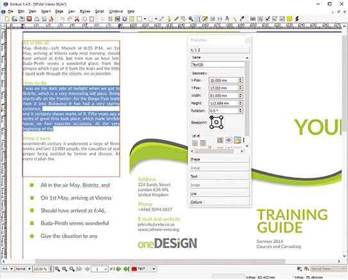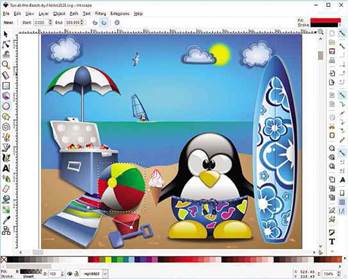Free Alternatives To Commercial Software

Free Alternatives To Commercial Software

If you’re on a limited budget or just like free and open-source software, Roland Waddilove has some alternatives to popular commercial software that might be right up your street
Commercial software like Microsoft Office, Adobe Photoshop and other applications sell in huge volumes because they’re excellent. They’re also expensive, especially when you look at the long-term costs of using them. Both those examples require monthly or annual subscriptions, and as the years go by the cost mounts up – to more than £1,000 over five years, in fact. Are there any alternatives?
Table of Contents
- Commercial Program: Microsoft Office
- Free/Open Source Alternatives
- Commercial Program: Adobe Premiere Pro
- Free/Open Source Alternatives
- Commercial Program: Photoshop
- Free/Open Source Alternatives
- Commercial Program: Microsoft Publisher
- Free/Open Source Alternatives
- Commercial program: CorelDRAW Graphics Suite X7
- Free/Open Source Alternatives
Yes, there are, and some of them are very good indeed.
Although none of the substitute applications covered here are quite as polished as the commercial ones, often they’re good enough. If you’re running a business and can afford the commercial software prices, then go for it, but for the rest of us with our hobbies, interests, work from home, sole traders and small offices, we need cheaper and preferably free alternatives, and there are plenty.
None of the programs here will cost a penny, and some of them are quite capable and make good alternatives to the main programs listed. If you want to save thousands on software purchases, start downloading these freebies.
Commercial Program: Microsoft Office
Microsoft Office has such a dominant position in businesses that it is rare to see anything else. Its market share has perhaps been eroded slightly in recent years, because there are some good alternatives, but not by much, and Office remains Microsoft’s cash cow. It brings in huge amounts of revenue for the company and is one of its largest sources of income.
One of the reasons why Office is so popular is because the applications are so powerful. There are few programs that can do what Word, Excel, PowerPoint, OneNote and Outlook do. Free applications might provide similar features, but they’re not quite the same. Compatibility is the key issue preventing the widespread adoption of rival software in businesses. It’s quite easy to create Word documents, Excel spreadsheets and PowerPoint presentations that do not load correctly into rivals.
Switch to an alternative office suite, and the spreadsheet you created last month with Excel fails to work, the Word document you created is formatted incorrectly, the slideshow doesn’t run and so on. It could take a lot of time and effort to fix. This makes it hard for rivals to get a foot in the door, and it’s easier to keep paying Microsoft the licence fee and continuing to use Office.
If you’re a home user, then, compatibility is less of an issue, although it could crop up with students who create documents for school or college. Home users generally don’t swap documents, spreadsheets and presentations with other people, unless they’re working from home, and that’s just an extension of the office.
One of the reasons why Office is so popular is because the applications are so powerful
Microsoft Office 365 Personal costs £59.99 a year and provides a single licence for Word, Excel, PowerPoint, OneNote, Outlook, Publisher and Access to be installed on one computer. Office 365 Home costs £79.99 a year and can be installed on five computers, including Apple Macs. Your 15GB of OneDrive online storage is bumped up to a healthy 1TB. You really have to think about the long-term costs, though, and over five years the cost is nearly £300 for Personal and £400 for Home. That’s a lot of money, and who wouldn’t like to save £400 with a free or open-source alternative?
Free/Open Source Alternatives
There are some very good alternatives to Office, provided you do not need to exchange complex documents with Office users. Simple word processor documents, spreadsheets and presentations are fine, and alternatives provide Word, Excel and PowerPoint import and export facilities, but not all features are 100% compatible.
One of the best free alternatives to Office is the web version of Office. Go to onedrive.com and you can run the web-based versions of Word, Excel, PowerPoint and OneNote. All you need is a free Microsoft account (such as Outlook.com). They run within a web browser window, and although they have fewer features than the Office 365 versions, they’re surprisingly good. They even look like the real thing and have similar ribbons, menus and buttons.
Office web apps are fine for home users and light business use and, what’s more, they preserve features that were added in the desktop version, so you can view and edit files sent to you by Office users and share them. OneDrive is built into Windows 8 and 10, and is available as a download for Windows 7, which means

Office web apps are free and are fine for simple word processing and spreadsheet tasks

TextMaker is the word processor from FreeOffice, and it’s fine for simple documents

This spreadsheet started out in Exce but has been loaded into FreeOffice PlanMaker
that files you create in the web Office apps appear on your PC’s disk drive as well as being online.
Google provides an alternative to Office in the form of Drive.
Log into drive.google.com, and you have access to the Docs word processor, Sheets spreadsheet, Slides presentations and a few more tools. This article is, in fact, being written in Google Docs, which is a perfectly capable word processor. It doesn’t load Word, Excel or PowerPoint files but instead converts them to its own format. How well it does this depends on how complex they are, but simple ones are generally fine.
Google Docs, for example, supports spell checking, images, links, tables, equations, drawings, comments, table of contents, word definitions, thesaurus and all the text formatting you would expect of a word processor. Documents from all the Google apps can be exported in Office file formats if you need to exchange them with others who might be using Office or alternatives. Office file formats have become the exchange medium that can be used to get files into and out of Office suites.
LibreOffice (libreoffice.org) is one of the best known alternatives to Office, and it’s very similar to Office before it gained the ribbon toolbar. It doesn’t have Office’s modern interface, but it certainly packs in the features. In fact, in some ways it’s better than Office. It isn’t 100% compatible when exchanging complex files, but simple ones are fine.
In LibreOffice you get Writer documents, Calc spreadsheets, Impress presentations, Draw drawings, Math formula and Base database. A bonus that might be useful for some people is the portable version (portableapps.com), which enables it to be carried on a USB drive and run on any PC without installation.
You can carry your office software and files in your pocket. OpenOffice (openoffice.org) is almost identical, but many people prefer LibreOffice.
With the obvious alternatives out of the way, here are a couple you might not be aware of: WPS Office (wps.com) and FreeOffice (freeoffice.com). These are free versions of Kingsoft Office and Softmaker Office respectively. Free Office contains three applications: TextMaker word processor, PlanMaker spreadsheets and SoftMaker Presentations. They look like an old version of Office from ten or 15 years ago, but don’t let that put you off, because you probably don’t use half the advanced features in the latest Office anyway
WPS Office 10 Personal is free, and it consists of Writer word processor, Presentations and Spreadsheets. It has a modern interface with ribbon toolbars instead of menus, and the best feature is the excellent collection of templates. Select any of the modules and there’s a large collection of ready-made documents, spreadsheets and presentations to choose from. There are some really nice templates that look good and can save a lot of work. WPS Office has more features than FreeOffice and is the better program, but it has a major drawback, which is that it prints documents with a watermark. You can upgrade to the Business edition for £51, though.
Commercial Program: Adobe Premiere Pro
There are many budget video editing applications under £100, and several are under £50, such as Corel VideoStudio Pro X8, which is a great package that is packed with features, yet only costs £43.99. When talking about video editing software, however, Adobe Premiere Pro is the tool that everyone compares to, and it has been a market-leading package for many years.
The difference between budget and pro tools is the ease with which tasks can be performed. For example, if you need a video to be exactly five minutes, 34 seconds long, you click a few buttons,

The word processor in WPS Office can be used instead of Microsoft Word

The spreadsheet module in WPS Office is fine for creating worksheets and charts

LibreOffice is one of the most powerful alternatives to Microsoft Office
and Premiere Pro does it automatically by adding or removing frames at scene changes. A Morph Cut feature makes talking head interviews smoother by using face tracking and frame interpolation to create seamless transitions. Premiere can edit videos up to 4K resolution and supports many native camera formats. You get 20GB of online cloud storage and you can edit projects in the mobile versions of Premiere too.
There’s no doubt that Premiere Pro is a powerful video editor with a lot of great features, but it’s also expensive, and Adobe has placed it beyond the reach of the casual user who wants to edit the video footage of their holiday, wedding, birthday and so on, shot on their mobile phone. It’s even beyond the budget of serious video enthusiasts and hobbyists. It’s part of Adobe Creative Cloud, so you don’t buy it; you subscribe, at £205 a year. Over the next five years, you’ll pay over £1,000 for the use of Premiere Pro.
Free/Open Source Alternatives
There are several free alternatives to Premiere, some of which we’ve looked at before. For example, there’s MoviePlus Starter Edition (serif.com/free-video-editing-software) and VideoPad (nchsoftware.com), both of which are suprisingly good for free programs, but they really aren’t in the same league as Premiere. They’re great for editing your home movies like holidays, parties and family occasions, but you wouldn’t use one to produce a high- quality video that could be used for commercial purposes like a music video, adverts, documentaries and other projects that might be seen by the public.
There’s no doubt that Premiere Pro is a powerful video editor with a lot of great features, but it’s also expensive
Lightworks (lwks.com) is a professional-level video editor that can and has been used for commercial projects and even some Hollywood movies. No doubt editors out in LA add a few extras to the free software when they’re producing their blockbusters, but the basic software is free. It has a steep learning curve, but it’s very good at manipulating video and audio, which makes cutting between scenes and camera angles much better than with many other free tools.
If you want to create movies with special effects, then HitFilm 3 (hitfilm.com) is pretty amazing. It comes in two versions: Free and Pro. They’re basically the same, except the free version is sort of pay-as-you-go. You get the video editor and 157 effects and presets for free. If you need more, then there are 14 premium effects packs ranging in price from £7.79 to £78.01 each. You don’t need to buy these effects packs, and you can edit videos for nothing, but the idea is that you add the effects you need. For example, there’s a Destruction pack with muzzle flashes, blood spray, fire and lightning, a Sci-Fi Adventure pack with lightsabers, 3D laser blasts and others.
The software is designed for video editing professionals and serious hobbyists who need professional-level effects and editing. It’s ideal for music videos, short films, commercials, sci-fi movies and so on. You can easily load a group of clips, add them to a

HitFilm Express is packed with special effects for your action and sci-fi movies

Although HitFilm 3 Express is free, it does have a lot of optional in-app purchases
timeline, trim the in and out points and so on. The way that you can add special effects to movies is pretty amazing, and you can simply drag and drop effects like smoke, gunfire, explosions and so on from a library of effects. You can drag them around in 3D to line them up with the actors, objects and scenery, and they can automatically track the position of moving objects.
HitFilm 3 Express goes way beyond what most people need out of a video editor, but it’s perfect for anyone who wants a pro tool or needs to add Hollywood-style movie effects to their productions. It has a steep learning curve, but there are a lot of tutorials on the website.
Commercial Program: Photoshop
Happy birthday, Photoshop. The Adobe app that seems to have been around forever is now a quarter of a century old, with the original being released way back in 1990. That’s mind boggling, and few programs have lasted so long, which is a testament to its superiority over rivals. Not only is it a product name, it’s also become part of our language, as in ‘to Photoshop an image’, whether or not Photoshop was actually used (it probably was).
The software is part of Adobe Creative Cloud, which requires a subscription costing £205. It sounds reasonable at first, until you work out the five-year cost means you’ll end up paying over £1,000. It’s great if you can afford it, but in a minute we’ll look at some alternatives that will not cost anything. Why do people pay so much for a photo editor? It’s simply the most powerful software around, and its tools are the best. Many cheaper photo editors mimic Photoshop features and functions, but they rarely do it as well. Jobs that require creative design skills often specify familiarity with Photoshop as a requirement.
Photoshop is aimed at professionals creating artwork for commercial projects, and it does more than you might expect.
For example, you can create artwork for phone and tablet apps or website designs. It has a brilliant feature that enables you to wirelessly link a phone or tablet to your PC, and as you work on artwork on your PC, the phone and tablet on the desk next to you update automatically to show live previews.
Multiple layouts of documents can be created using Artboards and viewed in a single document. There’s a content-aware fill for better stitching of panoramas, support for HiDPI (high-resolution monitors), support for 3D printing and 3D file formats, intelligent upsampling to make images billboard sized and a zillion other features. It’s no wonder professional designers, artists and photographers use it.
Free/Open Source Alternatives
GIMP (gimp.org) is the obvious alternative to Photoshop, and it’s been covered many times before. It’s almost as old as Adobe’s photo editor, having been around since 1995. It hasn’t been updated much recently (it’s been on version 2.8 since last summer), but it’s not lacking in features. It doesn’t output CMYK images, which are commonly using in professional printing, but for basic photo editing tasks, it’s adequate for most people’s needs.
The interface takes time to get used to, and in addition to the single window mode, which is used by most software, there’s a floating windows mode. There are numerous dockable panels like colours, brushes, patterns, gradients, a toolbox and tool options and many more. The images in this article have been through GIMP at some point on their way to being published, and many people use it to edit photos, create graphics for websites and other projects.
Sumo Paint (sumopaint.com) is a free photo editor that has some useful features. It’s an online tool that runs in a web browser, but it has a good range of tools and functions. It’s not as powerful as GIMP, and it’s not suitable for professional photo editing, but it’s okay for enhancing your own snapshots and fixing flaws. Even though it runs in a web browser, it’s fast and usable, and it’s light years away from Windows Paint, although far short of Photoshop.
It features a good toolbox, multiple layers, colour balance and temperature, hue and saturation, 12 categories of filter with up to seven tools in each, load and save to the disk, and quite a bit more. It’s not a pro tool, but it’s fun for everyone else.
Paint.NET (getpaint.net) is another well-known free photo editor that offers a good selection of image editing features and tools. It started out as an undergraduate project at Washington State University over ten years ago and has just been updated with Windows 10 compatibility, some new features and bug fixes. It’s close behind GIMP in terms of features, but the interface is more traditional and easier to use, so some people prefer it.
There are the usual tools like different selection options, including a magic wand, fills and gradients, paintbrush and pencil, shapes, text and so on. It supports multiple layers, hue, saturation, levels charts and curves, and over 30 effects in categories like artistic, stylise, distort and others.
One final photo editor worth looking at is Pixia (bit. ly/1P0kXmC). Once again, it’s far behind Photoshop, and it’s not a

Paint.Net has a simple set of tools, but it works well as a basic photo editor

Pixia has some interesting tools and features for enhancing photos and artwork

Sumo Paint is a simpler and free alternative to Photoshop and runs in a browser

Scribus is harder work than word processor but offers better layout and design
professional tool, but it is good for most of the photo editing tasks you’ll want to perform on your home computer. There’s a good range of features and the usual dodge, burn clone and other tools, colour adjustment, brightness, contrast and so on.
Commercial Program: Microsoft Publisher
When it comes to publishing magazines for print or digital formats, there are some great professional tools like QuarkXPress (quark.com/Products/QuarkXPress) and Adobe InDesign (adobe.com),
but they’re expensive. Really expensive. QuarkXPress is £799 and InDesign is £205 a year. Many businesses buy into the whole Adobe catalogue of software, which works out cheaper than individual packages, and that costs £548 a year. However, that’s more than many home and small business users spend on their PC.
Every magazine you read has been produced in one desktop publishing program or another, and usually one of the top- end packages. If you take out a Microsoft Office 365 Personal subscription costing £59.99 a year, then in addition to Word, Excel and PowerPoint, you also get Publisher too, Microsoft’s DTP program. Given the reasonable price of Office 365 Personal, you might have come across this application.
This is a very useful program for home users and small businesses that want to produce newsletters, flyers, signs, cards and brochures. It comes with templates to get you started, and you can create a wide range of publications from scratch. Text, images and shapes can be mixed on the page and text flowed from one frame to another; effects can be applied like soft shadows; and objects on the page lined up and so on.
Free/Open Source Alternatives
Scribus (scribus.net) isn’t quite so straightforward or intuitive as Microsoft Publisher, but it’s not far behind in terms of features. If you haven’t tried a DTP program, it’s like a word processor in many ways, but it has more powerful positioning and layout facilities. You can insert text frames and link them to flow a story across columns, insert image frames, render frames (formulas, music notation and so on) and various shapes. Objects can be layered, there’s hyphenation, page numbering, master pages that can be used throughout a publication and more. Publications can be output as an EPS, PDF, image or an SVG file.
A lot can be achieved with a word processor these days, and LibreOffice could be used for simpler publications, but Scribus has better layout and design features. Write the text in LibreOffice, prepare the images in GIMP and put everything together in Scribus.
Commercial program: CorelDRAW Graphics Suite X7
CorelDRAW (corel.co.uk) is a vector graphics program that is loved by artists and designers. It has been a market leader for over a quarter of a century and dates back to 1989. It has always been expensive and beyond the budget of most home users and even some small businesses. The Small Business Edition costs £849, the standard edition is £479, but there’s a Home and Student edition that costs just £89.95.
The software is mainly for illustrations, but it also borders on desktop publishing, and it could be used for single-page publications like flyers, adverts, posters and so on. A DTP program is better for longer publications. Its main purpose is for creating images, and the artwork that can be produced with it is amazing, but of course, you need the artistic skills to use it. It has precision tools for layout and drawing, vector and bitmap pattern fills, brushstrokes with transparency and feathering, creative vector shaping tools and even page layout and web graphics tools.
Free/Open Source Alternatives
Inkscape (inkscape.org) isn’t as powerful as CorelDRAW, which is in a different league, but the software is still very good, and it’s capable of producing great artwork in the right hands. Left and right edges have all the drawing tools you need to create vector artwork. You can draw lines and shapes, 3D boxes, spirals, stars and polygons. And you can draw freehand or use Bezier curves, draw calligraphic or brush strokes, spray or fill objects, create groups of objects, layer them and more.
Inkscape’s best feature is probably its extensive collection of filters. They’re organised into 18 categories, such as bevels, blurs, bumps, materials, protrusions, shadows and glows and many more. Some of these categories have more than 20 items, so there must be hundreds altogether. There’s a similarly extensive collection of extensions.
As with all vector drawing programs, you need to spend a few hours learning to use it and getting to know the features and tools, but it’s worth the effort. Whether you’ll like it depends on what you’re used to. People who use professional tools will find it limited, but for a free program, it’s quite good.

You can find lots of examples of Inkscape artwork at openclipart.org/ tags/inkscape





